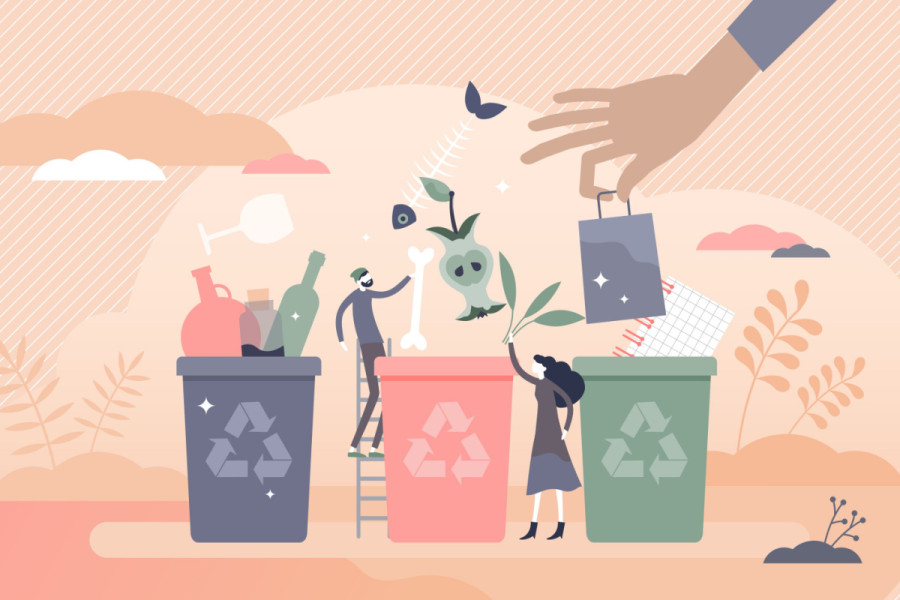Columns
Sustainable waste management
Bringing ready-to-cook food will reduce the amount of food waste entering the city.
Surendra Pradhan
Recently, Kathmandu Metropolitan City (KMC) published a public notice asking people to segregate biodegradable and non-degradable waste before giving it to the collectors. Several people support this idea and believe that this will miraculously solve the waste management situation in Kathmandu. There is a discussion going on about producing compost from biodegradable waste, recycling what can be reused and incinerating the rest. All these ideas sound suitable for waste management, but the million-dollar question is whether these waste management ideas are feasible and practical for Kathmandu.
Waste segregation means we need more containers to store different types of trash and more trips to the landfill sites to dispose of it, increasing the management costs. Monitoring segregated household garbage is complex, and it is not always pure, so biodegradable waste still needs separation of impurities, which can be costly. Composting is a slow process and needs lots of space and time. Many compost plants in Kathmandu have failed for lack of a compost market. Similarly, waste incineration is expensive and consumes a significant amount of energy. The heat from the incineration plants can be sold to large industries such as cement factories, but it is necessary to lay a good network of pipes which is expensive and unwieldy.
Besides waste segregation at home, KMC needs to consider alternative waste management procedures that suit Kathmandu. Waste management experts have suggested a simple, well-known principle for sustainable waste management, that is reduce, recover and recycle. These principles will help solve the waste management issue in Kathmandu to a great extent.
Reduction of waste
First, we need to understand the waste flow scenario to reduce waste production. Most of the food waste generated in KMC comes from raw or unprocessed food transported from outside Kathmandu Valley. Encouraging the transport of ready-to-cook or ready-to-use food (for example, peeled and chopped potatoes), vegetables, meat and other products will prevent a significant amount of food waste from entering the city. For example, 15 percent of a potato is turned into waste after it is peeled and made ready for cooking. Kathmandu consumes about 92,000 tonnes of potatoes annually, producing 14,000 tonnes of potato peel in the process.
Similarly, Kathmandu consumes 34,000 tonnes of meat products per year, which means that 20,000 tonnes of animal waste is produced annually. This can be reduced by bringing processed meat instead of live animals from outside. Many other products come with possible waste, which can be reduced by bringing the processed product. Transporting ready-to-cook meat instead of live animals reduces the waste load and makes the product cheaper. Promoting organic waste consumption at home through rooftop farming needs more encouragement. It is also essential to support window farming in Kathmandu since a significant number of people live in rented rooms or apartments which don’t have access to the rooftop.
Recovery and recycling
Nepal imports 985 tonnes of coal annually, spending Rs1 billion in 2020. But recycling our organic waste could help us substitute briquettes for coal. There are several ways to produce briquettes from municipal solid waste, but a simple method is to mechanically dewater organic waste mixed with a binder and press it in a mould and dry it. This briquette can be used for energy by different industries such as brick and cement factories. In this model, only a few companies can consume the entire briquette production. KMC produces about 73,000 tonnes of municipal waste annually or 40,000 tons of organic waste. Organic waste contains about 90 percent moisture, which needs to be screw pressed to dewater it and reduce 80 percent of its weight and 50 percent of its volume. Based on this calculation, 8,000 tonnes of briquettes can be produced from Kathmandu’s organic waste annually, compensating for the coal needed in Nepal and reducing imports.
Kathmandu produces 550 tonnes of plastic waste annually. Briquette from plastic waste has already been tested in Nepal on a small scale. Plastic briquette is an excellent solution to eliminate non-recyclable plastic, but cleaning harmful flue gas can be expensive. Furthermore, this needs several processes and heat energy which might be costly. Changing the policy to produce recyclable plastic and recycling it into new plastic would be a better solution. However, if the kiln or boiler can accommodate burning raw plastics, this might be beneficial since plastic has a high calorific value: 10,000 Kcal/kg.
Significant debris pollution is caused by empty plastic bottles commonly found along riverbanks. About 400,000 plastic bottles are thrown away in Kathmandu every day. Plastic bottle pollution can be controlled by making the companies that use them, such as mineral water and beverage-producing companies, responsible for managing empty plastic bottles. Perhaps they can pay for the empty bottles (for example, Rs5 each) so the consumer will collect and sell them instead of tossing them out on the street. Producing valuable/saleable bottles by any plastic bottle user company is common practice to reduce plastic bottle pollution in many developed countries, including Finland.
It is well known that there are many opportunities to recover value from different waste streams, but only a tiny part of it is recycled, and a large portion is dumped without recovering its value. Many factors need to work together to turn to deal with waste, and one of the most critical factors is to develop the concept of the waste recycling business. A quick example of a functional waste business is waste collection from households because it is simple and profitable for the entrepreneur. Waste entrepreneurs receive a fee from households, so they collect their waste and send it to the landfill site. Managing a more significant amount of accumulated waste is complicated, expensive and needs a considerable amount of effort from the local government. Public-private partnership is a very successful model for municipal waste management. For this model, the local government needs an excellent policy such as economic support, subsidies, low-interest loans, investment guarantee and market guarantees for their products (biogas, electricity, compost, animal food, protein) to attract entrepreneurs. And, of course, it is necessary to work closely with other stakeholders.




 12.12°C Kathmandu
12.12°C Kathmandu













%20(1).jpg&w=300&height=200)

